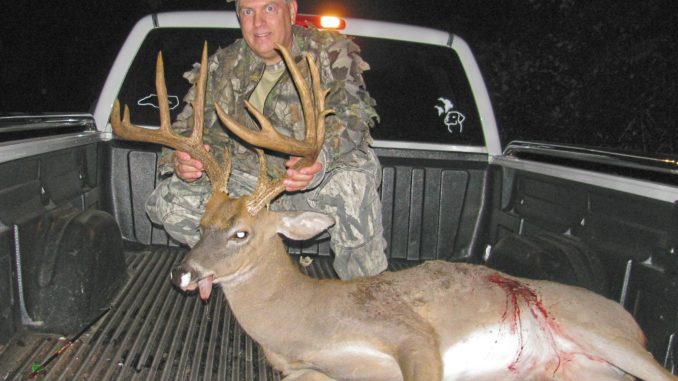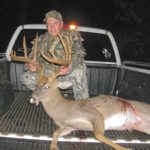
The advent of new technology has opened up archery hunting to plenty of deer hunters in North Carolina.
The moment of truth came for Oxford’s Randy Williams at 6:30 p.m. last Sept. 14.
A deer hunter for about 35 years who had killed several nice bucks with a muzzleloader and rifle, he had taken up bow hunting about 10 years ago.
“I practiced shooting about every August day to get ready for bow season,” he said.
Williams had polished his shooting skills enough that he could put every arrow in his quiver into a pie-pan size target out to 60 yards. A deadly shot with his Mathews Z7 compound bow, he also lived in deer-rich Granville County.
A week earlier, on the first day of the 2013 archery season, he’d watched from his ladder stand as 15 bucks and five does walked into a soybean field.
“Most had small to mid-sized racks, but four would easily gross 150 (Boone and Crockett) — or better,” Williams said. “I watched all of these deer and took several pictures with my iPhone.”
He was back in the same ladder stand, which he’d earlier moved across the field to a bottom near a trail he’d watched the deer use as they entered the field. Williams, 53, was hoping to take his first archery shot ever at a deer.
At 6:30 p.m., after he’d watched several does, a few spikes and four big 8-pointers feed on the sparse growth of the late-planted bean field, Williams heard a rustling noise in the woods to his left rear.
“It was about 75 yards from my stand,” he said. “When I turned to look, I saw a wall of horns running out of the cutover straight towards my 45-yard marker.”
Williams had cut small maple limbs and stuck them into the ground in the bean field at 15-yard intervals out to 60 yards for range indicators. He eased his bow off its hangar and pulled back its drawstring but lowered the riser as the deer took a several steps farther away.
“I let down the bow for a few seconds,” he said. “Then the deer turned and headed back a few yards, presenting me with a slightly-angled broadside shot at 55 yards. I was comfortable taking this shot as I’d practiced at 60 yards many times. I knew it was now or never, so I drew the bow back, settled my pin and touched off the release.”
Bow/crossbow use rises
According to a statistical analysis of bowhunting shots versus hit deer, Williams took one of approximately 205,170 archery shots at whitetails last year in North Carolina. The formula used is 14 arrows flung for each deer hit, and 14,655 deer were taken by archery hunters last season.
That’s a record, and what’s interesting is the previous season had proven a theory by Evin Stanford, the N.C. Wildlife Resources Commission’s deer guru, about the key factor in state harvests — it rises or falls depending upon the acorn crop. In 2012-13, the deer harvest fell because bucks and does stayed in the woods eating acorns instead of coming into fields to chow down on soybeans, unharvested corn and bait piles, putting themselves within range of Muzzy and Rage gods. Many people accustomed to seeing dozens of deer in fields became alarmed, thinking some terrible disease had struck.
“It was just a good mast year, and deer stayed in the woods,” Stanford said.
If you follow Stanford’s logic, it also means that most bowhunters hang their stands along the edges of fields — instead of in the deep woods — where they’ll have unimpeded lines of sight to their targets. It also follows that archers drill a bunch of bucks and does at bait piles.
So the trend of big acorn falls and fewer falling deer closely follows harvest statistics.
In 2007-08, the archery harvest broke 10,000 for the first time with a total of 11,429, and it steadily climbed the next two seasons, both of which featured poor mast crops. In 2008-09, bowhunters took 12,292 deer, and in 2009-10, it was 13,104. But a big acorn crop in 2010-11 dropped the harvest to 11,337.
By the next season, the Commission had approved crossbows for everyone — not just those with medical conditions prevented them from using traditional archery equipment.
Stanford has parsed archery harvest totals since 2011-12 between bow (11,971) and crossbow kills (3,885). In 2012-13, 11,542 deer were taken by bows and 4,542 by crossbows. Last year hunters using more traditional equipment tagged 14,655 deer, and hunters using crossbows nailed 6,466.
The use of crossbows also has meant a jump in deer-hunting participation by females. Anyone who attended the 2014 Dixie Deer Classic in Raleigh and saw the trophy deer entered by the distaff side knows that demographic is enlarging — and the ladies don’t mind pulling the trigger of a compound or crossbow.
Food is September key
Randy Williams spent last September in Granville County, one of the northern tier of counties where hunters have a real chance to encounter large-racked deer, and his experience proved another important factor in early-season success — food sources are crucial.
When archery season begins statewide, it’s too early for rutting activity, and most male deer 18 months or older hang out with other bucks in bachelor groups. They show little interest in does until the end of October, but they know the rigors of the mating season are ahead, so they must add body weight. That’s where food ability enters the picture.
Early September may be a little early for acorns to drop, but when they fall, Stanford said deer will ignore most agricultural foods, especially for white oak acorns.
In the absence of acorns on the ground, soybeans are hard to beat because they’re packed with protein, which helps build body mass. When a deer’s body weight maxes out, that’s when proteins and minerals go toward growing antlers. Peanuts are another big protein source for deer that live in areas where they’re grown.
Williams said he was fortunate that the farm he was hunting featured a crop of soybeans that had been planted relatively late.
From his ladder stand, Williams had watched the buck and decided it was time to take his shot.
“After seeing the large rack coming into the field, I conscientiously didn’t look at the horns,” he said. “I’ve seen and taken several huge bucks over the years and instantly knew this one was a shooter. I suspect the big buck truly thought it was running out to beat other deer to the nice green patch of soybeans, as there were several deer close by me.”
Williams’ son, Carson, an N.C. State graduate student, was in a stand about 300 yards from his dad watching through binoculars.
When he released the arrow, it thwacked into the buck’s side, and the animal bolted away across the field and into the woods. After waiting more than an hour until dark — during that time Williams’ son missed a 9-pointer and an 8-pointer — they found the deer in a honeysuckle thicket.
Williams’ 14-pointer measured 155 gross inches, and after deductions, it scored 147 3/8 net, making it his best buck ever.
The two hunters used a “truck trick” to direct deer toward their stands. While deer often become accustomed to tractors and other farm equipment, if they’ve been hunted, they often shy away from autos parked in the open. Because the field they hunted was so large, Randy Williams and his son wanted to push deer toward their side of the field.
“While driving to our stand location, we devised a plan to contain the bucks between us,” Randy said. “We parked my truck so that it would be visible to deer that tried to move to the far side of the field out of our range. I wanted Carson to get a chance at one of those bucks we’d been watching all summer.”
Crossbow giant
Crossbows are attracting many converts. Although some people find them difficult to cock, they are deadly out to 40 or 45 yards. With scopes mounted on top, releasing a crossbow “bolt” is almost like shooting a rifle.
Although crossbows don’t have shocking power similar to rifles, cranked up to 150 or 175 pounds, they will slam a broadhead through a deer without much trouble.
“And you don’t have to practice (shooting) a lot,” said Matthew Alcon of Alamance County’s Stoney Creek community, who was using a TenPoint crossbow with a scope mounted and sighted in at the factory when he killed last year’s biggest crossbow buck in North Carolina.
“I’ve been bow hunting since I was 13 or 14 years old,” said Alcon, a 27-year-old MBA graduate from UNC-Greensboro. “I still have my compound bow, and I’ll probably use it again, but the crossbow shoots arrows at 300 feet per second, really flat, and for a short distance, it’s really fast.”
His main secret in bagging a buck with a nearly-perfect 5×5 rack that scored 155 2/8 gross and 152 2/8 net inches at the 2014 Dixie Deer Classic actually isn’t a secret.
“I use trail cameras,” Alcon said. “I also had put a mineral block out, and he’d been coming, but always at night, every night for the previous two weeks. I had hundreds of pictures of him.”
His cameras were set up along a hedgerow between two soybean fields, and just before the season opened on Sept. 7, a camera caught the buck entering the field 30 minutes before dark.
Alcon climbed into his stand between 5:30 and 6 p.m., and after 30 minutes, he heard the deer walking behind him.
“I had put a cattle mineral block on the ground, and it was completely gone. He walked out in front of me to the salt block. It was about 30 yards from me. I had put a cattle mineral block on the ground, and it was completely gone. He was standing where the salt block had been when I shot him.”
Alcon looked through his scope, put the crosshairs behind the buck’s shoulder and touched the trigger.
“I shoot Lumenoks, and I could see the Lumenok (near the buck’s shoulder), so I was worried it didn’t go through him,” he said.
The deer jumped, then ran directly on the path he’d taken into the field after having walked up the hedgerow.
Alcon waited 90 minutes before calling a friend, Ricky Patterson, who helped him trail the buck through the hedgerow, finding him 20 yards out in the other soybean field.







Be the first to comment